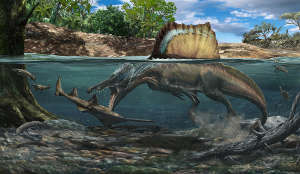Using AI to control energy for indoor agriculture
30 September 2024
Published online 24 March 2022
Study suggests that a family of carnivorous dinosaurs were adapted for an aquatic lifestyle.

Davide Bonadonna
Researchers have hypothesized that only a few non-avian dinosaur species were partly or predominantly aquatic, but it has been challenging to confirm this due to the difficulty of inferring anatomical adaptations in extinct species.
To investigate, Matteo Fabbri of the Field Museum of Natural History, Chicago, and colleagues in the US, UK, Italy, Spain, Argentina and Morocco, focused on bone density as an indicator of aquatic adaptation. Bone density has been used to infer aquatic habits among amniotes (the group including mammals and reptiles), but this is the first time it has been applied to non-avian dinosaurs. By comparing the densities of 380 bones from a wide range of extinct and living animals, including marine mammals, lizards, crocodiles, and various types of subaqueous foraging birds such as penguins and cormorants, the team found that Spinosaurus and its close relative Baryonyx had very dense, compact bones below the skull , suitable for an aquatic lifestyle. The dense bones would have been useful for buoyancy control while hunting underwater.
Another related dinosaur, Suchomimus, had less dense bones, suggesting that it may have waded in a manner similar to modern herons and spent more time on land.
“We were surprised to see such high bone density among spinosaurids, and even more surprised to see that some spinosaurs did not have this trait,” says Fabbri. “This means that while some spinosaurids were swimming underwater, others lost this behaviour and adapted to a more terrestrial ecology. In other words, we completely underestimated the ecological diversity of spinosaurs and, more in general, dinosaurs.”
The authors suggest that the increase in bone density may have preceded the evolution of more conspicuous bodily adaptations for life underwater, such as paddles, fins and flippers.
The findings suggest that adaptation to aquatic environments appeared in spinosaurids during the Early Cretaceous period (around 145 to 100.5 million years ago), following their divergence from other carnivorous dinosaurs during the Early Jurassic.
Fabbri says that the study’s large dataset can be applied to test ecological adaptations in other groups. One of the next challenges will be to test ecological diversity among Triassic reptiles and Mesozoic synapsids, including early mammals. “These groups might reveal big surprises,” he says.
Alexandra Houssaye of the CNRS/Muséum National d'Histoire Naturelle, France , who was not involved in the study, says the findings add to a growing body of literature supporting the view that Spinosaurus was indeed aquatic. “What we need now is more bones of specimens,” she says. “We have the femur (ribs are more ambiguous), but it would be great to obtain humerus data. X-rays of these two bones would enable us to understand aquatic locomotion more comprehensively in Spinosaurus.”
doi:10.1038/nmiddleeast.2022.13
Fabbri, M. et al. Subaqueous foraging among carnivorous dinosaurs. Nature https://doi.org/10.1038/s41586-022-04528-0 (2022).
Stay connected: